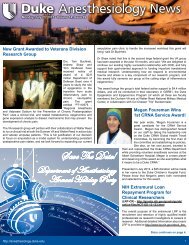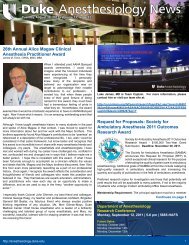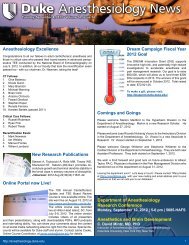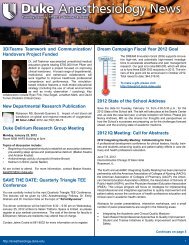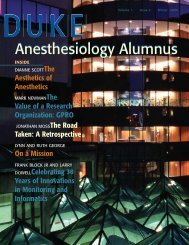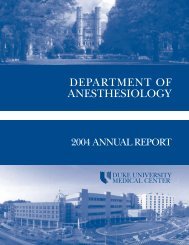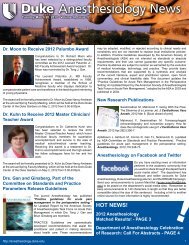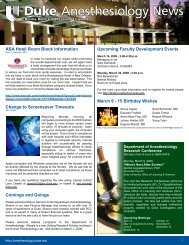DEPARTMENT OF ANESTHESIOLOGY ANNUAL REPORT
DEPARTMENT OF ANESTHESIOLOGY ANNUAL REPORT
DEPARTMENT OF ANESTHESIOLOGY ANNUAL REPORT
Create successful ePaper yourself
Turn your PDF publications into a flip-book with our unique Google optimized e-Paper software.
HISTORY <strong>OF</strong> THE <strong>DEPARTMENT</strong> <strong>OF</strong> <strong>ANESTHESIOLOGY</strong><br />
Like many American Departments of Anesthesia, the roots of the current Department lay in nurse anesthesia.<br />
In fact, from 1930 to 1944 all anesthesia at Duke was administered by nurses under the supervision of surgeons.<br />
Duke had one of the first schools of nurse anesthesia, begun in 1931 and pioneered nurse anesthesia education<br />
by extending the duration of education to two years in 1966. Dr. Ruth Martin was recruited as the first physician<br />
anesthetist in 1944 and she was succeeded in 1950 by the brilliant and energetic leader of anesthesia, Dr Ronald<br />
Stephen from Canada. During the Stephen years, the anesthesia residency flourished, as did clinical research.<br />
The residency grew from a number of 3 to 16 when Dr. Stephen left Duke in 1966.<br />
The Division of Anesthesia of the Department of Surgery became an independent academic Department of<br />
Anesthesia in 1968 under the guidance of Dr. Sarah Dent. In 1971, the distinguished professor and Chairman of<br />
Anesthesia at New York Downstate Medical Center and at the Pritzker School of Medicine in Chicago, Dr. Merel H.<br />
Harmel was recruited to Duke to continue to develop the young Department. The Department grew in quality and<br />
quantity with the addition of faculty and residents as well as the inauguration of a basic science research program.<br />
Clinical programs also were developed during this time with new programs in critical care medicine, hyperbaric<br />
medicine and pain management. Dr. Harmel retired from the chairmanship in 1983 and was followed by Dr. W.<br />
David Watkins who was recruited from the Harvard system. Dr. Watkins emphasized a strong residency program<br />
and increased the size from 29 to 50 residents in the seven years of his leadership. The Department continued to<br />
play an important institutional role boasting the Clinical Director of the Hyperbaric Medicine Center, Director of the<br />
Pediatric Intensive Care Unit, Co-Director of the Surgical Intensive Care Units at the VA and Duke Hospitals, and<br />
Director of the Duke Heart Center. Research also continued to expand as reflected by additional Ph.D. faculty and<br />
the award of multiple outside grants.<br />
The Department is now led by Dr. Jerry Reves, a cardiac anesthesiologist, whose plans include the development<br />
of stronger subspecialty anesthesia programs, creation of more fellowships, and emphasis of research in molecular<br />
pharmacology, neurobiology, and clinical pharmacology. With steady progress through the years, the Department<br />
is now poised to be one of the very few centers of academic excellence in the field of anesthesiology. All the<br />
requirements are in place: an outstanding well organized residency education program, a large and diverse clinical<br />
case load of over 35,000 operations and deliveries, superb facilities, solid research base, a first-rate Department of<br />
Surgery with which to work closely, and a Medical Center Administration committed to an Anesthesia Department<br />
of the highest order. This is probably the most exciting time in the entire history of Duke Anesthesia.




